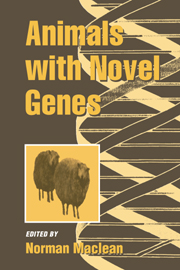7 - Minor transgenic systems
Published online by Cambridge University Press: 21 October 2009
Summary
The range of transgenic animals
As seen in previous chapters, animal species of many kinds have been used for experiments in transgenic induction. Some offer particular benefits to the experimentalist; others have proved difficult or even impossible to use. In this book we have attempted to review all of those in which transgenic induction has been successful. The present range is as follows: protozoans such as Paramecium and Trypanosomid species, a few species of sea urchins, the nematode Caenorhabditis elegans, a few insects such as the silk moth Bombyx, the mosquito Anopheles and the fruit fly Drosophila, the predatory mite Metaseiulus, fish of many species, the amphibian Xenopus laevis, the domestic chicken and both laboratory mammals such as rats, mice and rabbits and large mammals such as cattle, sheep and pigs.
The failures and successes of applying transgenic technology to all of these experimental systems makes fascinating reading, yet clearly we are only at the threshold of this interesting study area. As well as the major transgenic systems that we have addressed here, there are a number of interesting minor ones, which will be briefly reviewed in this chapter. Of course, since this book is about transgenic animals, we have not discussed the extensive work on transgenic plants, fungi such as yeast and Aspergillus or bacteria, in which transgenism is a way of life, facilitated as it is by the extensive range of natural plasmids.
- Type
- Chapter
- Information
- Animals with Novel Genes , pp. 245 - 254Publisher: Cambridge University PressPrint publication year: 1995



